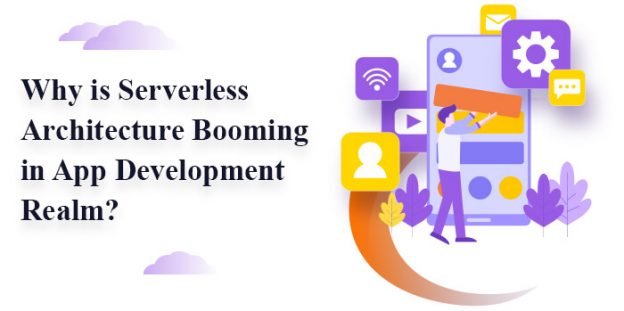Why is Serverless Architecture Booming in App Development Realm?

Serverless architecture is gradually becoming a broadly accepted approach for App development. Going serverless does not mean there is no involvement of server. It’s just that you do not have to own a whole lot of server and maintain it. You have to seek some third party often called as cloud companies in order to receive a cloud-based infrastructure. Amazon AWS, Microsoft Azure, Google Cloud are some of the eminent providers in the arena. If you are wondering what all parts of the overall building and maintenance process becomes their responsibility, then here is answer. They offer server management, configuration, scaling facilities, migration, networking, provisioning, security and other associated services.
What is Serverless Architecture?
Server Architecture is a software design pattern where the infrastructure is provided by a third-party cloud service as BaaS (Backend as a Service). Once the companies sign up with such service providers, they have to install an API at their end so that the services can be accessed. The payment is based on the amount of resources used by the application, but it works on Pay as you go model which makes it a convenient option for the small business holders as well. Here, the app development company just need to focus on development part and then it is sent to the vendor for further processes like testing, deployment and maintenance.
It is widely accepted by all sorts of businesses knowing that the most of their day light used to go in debugging, implementing and maintaining the infrastructure when they did not have such a concept. With such a huge burden being lifted from their head, businesses can now focus on accomplishing goals and thus appending more values to the system.
What is the idea behind serverless architecture?
As it is called serverLESS, a little of computing power residing on the hardware is still required to be done. With serverless architecture, the developers have to put a reduced amount of efforts to publish, maintain or scale the servers. This concept has brought significant ease in app development and dropped the process complexity. The companies still relying on the old procedure have to remain entangled in the process of maintaining server.
The modularity in the concept allow businesses to put their main focus on product development and business growth. With the ease bestowed by advanced technologies, a reduced patience level is often experienced by businesses. Any fault or lacking maintenance can immediately bring you stress due to which it becomes difficult to focus on the main functional area. Serverless approach also provides economic perks to the business irrespective of their size or age. Means, either it’s a start-up or well-established firm, there is no harm using serverless technique to cut out a lot of cost. Quick deployment, an early reach to the market, event driven project scaling and reduced cost are some of the benefits of serverless approach which we would detail in the further sections.
Serverless Architecture Frameworks
There is a set of components you require in order to work with the third-party vendors. The framework for application development involving serverless architecture includes following components.
1. Client application: Whether you take serverless approach or not, the client interface has to rendered on client side only. Though, to run client applications static web server is enough.
2. Web server: The web server which is used to render the client application should be robust so as to serve the static HTML, JavaScript and CSS.
3. FaaS solution: FaaS or Function as a Service is the most important component of serverless architecture. It allows developers develop, run and deploy application without having server infrastructure. Everything is available in FaaS from operating systems and tools to various frameworks.
4. User authentication: Once the app owner sign up with any serverless computing services, it is their responsibility to make sure that the user is able to login easily and quickly without facing any sort of hurdles.
5. Security token service: When serverless computing is adopted in a system, the users are given the service provider API to enter into the system and use its service. The serverless architecture should generate a security token for all the users then accessing API should be triggered.
6. Database: Database is another important component even if you have developed and made the application available through serverless computing. The data is stored in database hence it makes one of the components.
When to use Serverless architecture?
Not because everyone is going for it, you should adopt it too. Use Serverless architecture if,
1. You really want to give all your time to the product planning and development and not to debugging, implementing, provisioning, scaling and maintaining the infrastructure. This is one of the huge benefits of having Serverless architecture in place. You will be able to focus on your product rather than how it is maintained.
2. You do not want to deal with the complexities whenever scaling is required. It gets automatically done.
3. You want a reduction in the development cost due to low budget or saving the amount for other purposes. Using serverless architecture, you can bring down the cost without compromising on the quality of product.
4. It is a lightweight and flexible application you are coming up with. If it needs to be updated on a frequent basis then you should opt the serverless approach.
5. If you want to move to the market quickly.
How does such applications work?
Serverless applications run on cloud and hence are event driven. In such applications, UI remains the part of native mobile app, but the management and user authentication are left as a responsibility of BaaS services like AWS. Directly called by mobile apps, these services handle various user facing tasks e.g. Authentication, Registration etc. The same BaaS is used to retrieve the other backend components. Serverless computing has also made it easy to securely handle routing HTTP requests between a mobile app and your backend. It works on a systematic procedure where all the different operations are encapsulated in a function. AWS Lambda which is an FaaS platform runs such functions in parallel containers monitored separately. The thing that got better here is you can now solely focus upon logic of your app. Components can be decoupled now due to which developers can add new logic quickly without the inherent friction that was present in a monolithic architecture.
Popular categories of Serverless applications
1. Web application architecture: Serverless architecture is increasingly becoming the choice of web app owners especially single page applications on which pages are lighter and few dependencies are there. There is no need to maintain a shared server for the application as you have got many cloud services which help you build the API to connect with cloud and then its simple work for you to just login and run the code.
2. SaaS integration: Developing SaaS application has always been a challenge for the developers as the load keeps on fluctuating in terms of customers and tasks both. With the emergence of serverless concept, there is significant ease perceived by the developers as automatic scaling is inherent in such systems. Whenever you have load, you do not have to worry about maintaining the space.
3. IoT backend: It can be easily understood that if you have a large number of applications connected to your IoT network, managing them becomes a nightmare. The data is generated in huge chunks due to which your system starts lagging in terms of performance whereas it should always perform to its fullest. At this point, if you use serverless architecture it becomes easy for you to just focus on building the rules triggering registration logic, database search, activation code for activating the device is requesting access. It has brought a sigh of relief to engineers making their task this easy.
4. Mobile backend: Using Serverless architecture, developers can create applications just like native apps. While the end users use the application, serverless functions are called which are rendered by the cloud vendors. Hybrid mobile apps with a serverless backend allow developers to use the benefits of serverless computing when they releasing the applications performing much like the native apps on any phone. Serverless mobile apps offer a range of benefits including quick updates, less overhead, scalability and pay as you go nature. It reduces the ongoing cost to a great extent as you have to pay only for the computing power that the application uses.
Advantages of using Serverless Architecture:
1. Allows team to focus on goals: With serverless architecture, we can save much of our time and energy that can be channelized in accomplishing the goals and bringing innovations in the industry. When the operational time is reduced, the companies can easily adopt Agile methodologies and other positive approaches for project success. Project managers are hence provided with enough of freedom to let developers and team just focus on creating the business logic that bring innovation in the market. As a result, it leads to client satisfaction which is important to keep an organization growing.
2. Effortless operation management: While developing any solution, the condition of the infrastructure is always kept in mind. It is somewhere an obstacle in coming up with something innovative. With the ever-advancing technology, you have to evolve your solutions as well. Hence, traditional systems are hard to manage nowadays. With serverless concept, developers just have to think about providing their best without having to worry about the infrastructure. There is no need for continuous integration and accessing delivery tools now. If you are someone adopting DevOps approach in your company, then going serverless can make you achieve your milestones in a better way.
3. Quick scaling: Scaling is generally strenuous with the traditional systems whereas with the all new concept of serverless architecture, applications are scaled up very quickly. You do not have to worry about whether the infrastructure is even capable to scale or not. Developers can immediately start using new environment or services following just a few steps. Scaling process for Serverless is almost automatic and seamless but yes, there is lack or entire absence of control. Serverless concept is a quick key to scalability.
Disadvantages of Serverless architecture:
1. Complexity: The development of distributed computing architectures is time taking and complex at the same time whether you go for the traditional approach or serverless. With latter, you have decided the size of each function which is crucial and tough. We will tell you the outcomes of both the cases. If the function size is too small, there would be a huge mixture of functions coming under one application whereas with too big sizes, the implementation, testing and debugging cannot be optimized much. You have to select tools to perform each step which is a common problem among teams.
2. Third party API: If you give serverless architecture, you give up control on your application. Since the data is rendered directly from the third party, the end users might face some unexpected issues such as lesser security, forced updated etc.
3. Operational tools: There is a lack of operational tools and metrics provided by the cloud companies at the moment. There is a lot of problems faced by developers in debugging a system running on serverless concept. In the case of major issues, they do not even have enough tools to take some step or even redirect users to some other point.
4. Cold/Warm functions: There is no fixed time of launch in the case of serverless architecture. The function which has been used recently is called warm function and launches quickly whereas the one which has not been used from a long time becomes cold and takes time to launch.
Serverless architecture has a good amount of advantages which is why it can override the drawbacks and become the future of modern app development. By adopting this approach, one can make a quick access to the market with an added advantage of spending less. In all, serverless applications are seen to perform well in the market and are widely accepted by masses.






